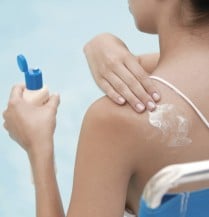How to Stay Safe in the Sun
When you live at the beach, being SUN-telligent is necessary. Having not grown up here, it took me a little time to gather all the tips and tricks to stay happy and healthy in the sun and avoid looking and feeling like a boiled lobster! It’s especially important for me to be diligent about sun protection for my kids. When you live on Sanibel Island, the temperature is warm enough that you can play outside on Christmas and Independence Day (and maybe even wear the same outfit). That means we think about sun safety all year round.
For all of you, those planning your visits to Sundial and everyone who is beginning to swap winter clothes for warm weather clothes and dreaming of the sun, here are some of the things I’ve learned that’ll help you keep yourself and your family protected while enjoying the outdoors.
- Understand the UV Index. Most of us know that midday is when the sun is strongest but what is “strong?” The below chart, from weather.com, shows the risk categories used to identify the levels of skin-damaging UV radiation.
| 0-2 | Low |
| 3-5 | Moderate |
| 6-7 | High |
| 8-10 | Very High |
| 10+ | Extreme |
- Here you can check the Current UV Index for the entire country at a glance. To plan ahead, try the UV Index Forecast. You can check out the maximum estimated index up to 10 days ahead.
- Thin Fabric may not be protecting you- It should be obvious to most of us that mesh or lace fabric offers virtually no buffer from the sun’s rays (I mean come on, there are holes in it), but very thin fabrics can also let the sun through. The rule of thumb is this: if you can see your hand through the material, the UV rays can see your skin.
- Sunscreen: How much? How often? What kind?This is straight from SkinCancer.org (Suncreens Explained), the Skin Cancer Foundation’s official website. I have found that this aspect of sun safety has been the one that is constantly changing in terms of recommendations so I defer to the experts. (*When shopping for sunscreen, consumers should look for The Skin Cancer Foundation’s Seal of Recommendation, which is awarded to sun protective products that meet stringent criteria for safety and effectiveness.)
You should probably double the amount of sunscreen you’re using right now. “To ensure that you get the full SPF of a sunscreen, you need to apply 1 oz – about a shot glass full. Studies show that most people apply only half to a quarter of that amount, which means the actual SPF they have on their body is lower than advertised. During a long day at the beach, one person should use around one half to one quarter of an 8 oz. bottle. Sunscreens should be applied 30 minutes before sun exposure to allow the ingredients to fully bind to the skin. Reapplication of sunscreen is just as important as putting it on in the first place, so reapply the same amount every two hours. Sunscreens should also be reapplied immediately after swimming, toweling off, or sweating a great deal.” “No sunscreen, regardless of strength, should be expected to stay effective longer than two hours without reapplication.” Set an alarm on your phone or find someway to remind yourself when it is time to reapply. The kind you get should be determined by skin’s sensitivity and the typical sun exposure you. Many facial products and daily lotions today already contain SPF but “if you work outside or spend a lot of time outdoors, you need stronger, water-resistant, beachwear-type sunscreen that holds together on your skin.”
I know it’s a lot to take in but it comes down to this:
- UV Index= intensity of the sun. Check it before you spend a long day outdoors.
- Clothing Fabric= if it’s too thin to block the rays, either change or apply sunscreen underneath
- Sunscreen= BUY IN BULK! Take a shot of sunscreen, slather all over self, repeat every 2 hours.
I hope these tips will help you all stay protected in the sun this Spring and Summer and insure that no one is doomed to the fate of the boiled lobster!
A note on SPF: SPF 15 filters out approximately 93 percent of all incoming UVB rays. SPF 30 keeps out 97 percent and SPF 50 keeps out 98 percent. They may seem like negligible differences, but if you are light-sensitive, or have a history of skin cancer, those extra percentages will make a difference. And as you can see, no sunscreen can block all UV rays.”






